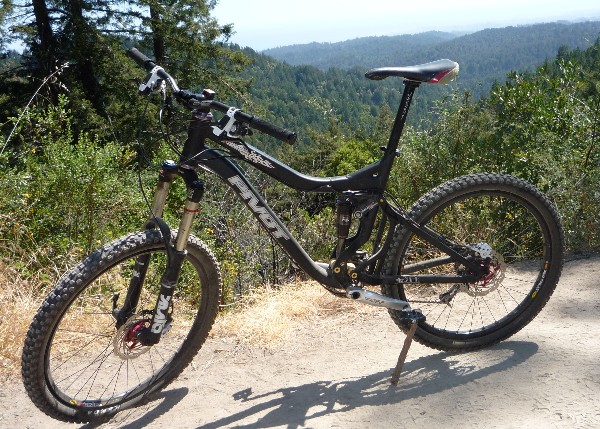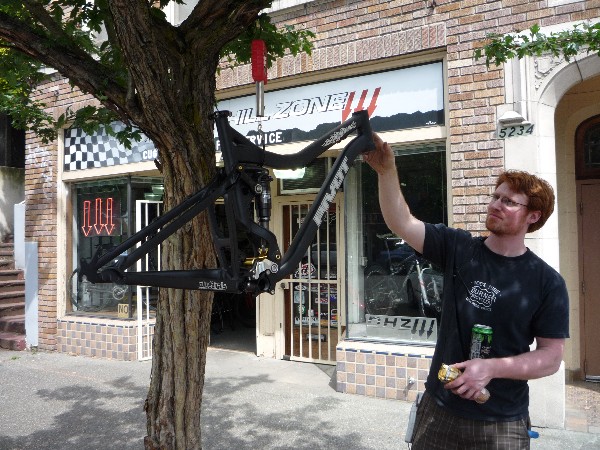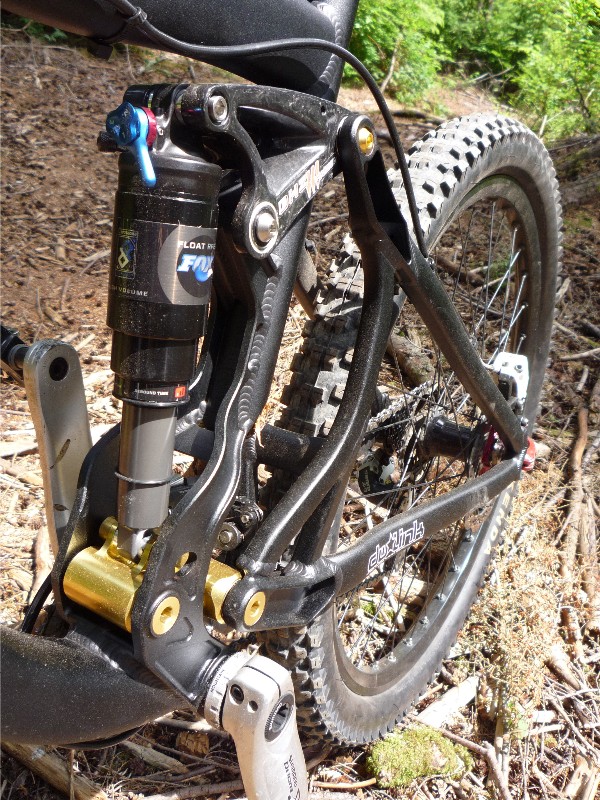[Note: Pivot will be bringing its bike fleet to Bothell Ski & Bike on Saturday and St. Edwards Park on Sunday (July 26 and 27) for demo-ing from 10 a.m. to 4 p.m. I bought a 6.5-inch Firebird with the DW-Link in mid-June and have ridden it virtually daily. It confirmed what my Ibis Mojo told me the first time around: Dave Weagle’s DW-Link is the biggest advance in mountain bike suspension technology in years — arguably since the advent of the air shock.]
The Pivot Firebird really resets the landscape for long-travel trail bikes. For the first time you can go with a heavier bike, in the 32-lb. range, and benefit rather than suffer from the weight gain. To be clear, you may not benefit on an epic cross-country ride with steep climbs and smooth trails. You’ll still appreciate your lightweight, 5-inch bike for those rides.
But mountain biking is going through an evolution right now, where trail riding is increasingly a step-up from classic XC to aggressive skills tests. Every summer I head to British Columbia, where trails are etched into steep, rocky, rooty, obstacle-laden and structure-enhanced terrain with jumps, drops and hucks. B.C. is setting the international standard these days, which means its burly kind of riding is already trickling down the ranks to Cali, Colorado, Utah and other MTB haunts. When I spent a couple of months living in the Bay Area recently, I was amazed at the emergence of technical stuff on traditional trails, as well as an explosion in new trail building aimed at upping the X-factor. Many of these trails are off the radar, but the groms can’t wait for red tape and process. They want to ride now.
I’d be reluctant to take my 25-lb. Mojo on these routes. The Mojo is air only, has a 4-lb. carbon fork and 717 Mavic wheels. It’s set up for all-day mountain epics or simple low-country trail riding unencumbered by chutes ‘n ladders. I realize Brian Lopes rides a Mojo in downhill dual slalom events. But he’s got a coil shock, beefy wheels and other tweaks, and he doesn’t have to pay for his bike. Most of all, he’s Brian Lopes. And you know what? The rest of us are not.
So where you benefit with a step-up to the Firebird is in confidence. And confidence, these days, is a big factor in how fulfilled you feel riding a mountain bike. Maybe you can do small jumps but not doubles. Maybe you can do 3-foot drops but not 5-footers. Maybe tabletops intimidate you. To take that next step you need a bike that will do what you want it to do, will follow where you lead, and will bail you out when gravity gets the better of you.
And that’s where the Firebird enters in.

I’ve ridden 6-inch bikes since converting my Ventana Salt (El Saltamontes) to a 6-inch kit five years ago (we didn’t know about geometry so much back then). I had a Turner 6-Pack for a bit, then went to an Intense 6.6. All good bikes, all increasing my skillz. But this year I knew I wasn’t advancing with the trails, and needed something more.
I almost went for a Santa Cruz Nomad. But its suspension technology, the VPP, is the same as the Intense, and I was itching to try something different.
The Firebird caught my eye immediately for two reasons. First was the presence of Chris Cocalis, formerly the head guy at Titus. I bought a Titus ti HC hardtail from Roaring Mouse Cycles in San Francisco seven years ago (which also, no surprise, carries Pivot today) and it hasn’t missed a day from downtime. I still ride it almost every day for my around-town bike (modified only slightly for street use), and will take it on the trail where the ride warrants. It’s crashed many times and even got hit (nudged) by a car on my van’s rear rack one time. Didn’t even bend the chain stay. With the ti, of course, its finish looks brand new if you swab it up with a little steel wool.
Cocalis knows his stuff, takes pride in his work, builds bikes to last and stands behind his product. Since he founded Pivot I’ve been waiting for him to come out with something I wanted. When he hit the streets with the DW–Link, I sat up straight. The Mach 4 or 5 did not make sense because I already had the Ibis. The Firebird, though, made sense.
I should say something here about elevated expectations. Mountain Bike Action‘s RC (Richard Cunningham) doesn’t put his own name on many bike reviews, but he did it for the Firebird. His online posting was a 5-star gobsmacked rave. RC is usually pretty reserved in both praise and criticism, so his unabashed love letter to the Firebird was a marked departure. It did, however, goose the buzz meter on the Firebird.
By that time I knew I was going to Sea Otter this year, and that Pivot would have Firebirds available for test rides. Sure enough, they had a size Large available in the booth when I walked up. They set me up and told me to go play, I could take as much as two hours on the bike.
I headed for the test track and then the XC course to put the Firebird through its paces. And wow, was I shocked. The bike was just ordinary. It felt harsh, unbalanced and unresponsive. Going over the track jumps I was always too far forward or too far back. Climbing up the singletrack my front end wandered. I couldn’t figure this bike out!
At the Pivot tent we’d spent at least 5 minutes getting the suspension dialed for me…or at least I thought. Setting the rear shock (the Pivot comes with either RP23 or DHX 5) is crucial. You want 30 percent, or 3/4th of an inch, not significantly more even though you might be used to setting sag lower. Everything else seemed in order.
But out on the trail, the Firebird just wasn’t doing it for me. Hugely disappointed, I went back to the tent and thanked the guys, making mental plans to order a Nomad the next day.
As it turns out, luck was with me. My LBS, the Downhill Zone in Seattle, could not obtain a Nomad in the color I wanted. I was forced to wait. And it gave me time to think.
My test ride was so at odds with everything else I’d read and heard about the Firebird, and I trusted Cocalis’ judgment so much, that I figured I should give it a second chance. Because it was the beginning of the season, my worst-case scenario in getting a Firebird would be to use it for a few weeks, then sell it. I’ve done this before with high–end bikes. It’s like renting for a summer for a couple hundred dollars.
Fortunately, the second wave of Firebirds was just coming over on the boat from Taiwan. When I put in the order, I was just a few days from getting the bike.

And here’s what happened. Adam at the DHZ set it up almost perfectly, nailing stem length, saddle position, bar width and on down the line. Adam knows me and my riding style and is a master at tailoring the ride to the rider. My riding weight with a pack is about Adam’s riding weight light, so he could dial the shock settings.
I took it out to Tiger Mountain, my favorite Seattle-area trail network, and thought in the parking lot that the shock, in my case the RP23, was a bit harsh. I fiddled with the air pressure, rebound and compression till the settings felt good. But Tiger starts out with a fairly steep fire road climb, and I was getting a bit too much depth on the travel ring. So I upped the air pressure just a hair…back to where Adam had it set in the first place!

At that point the DW-Link took over. For years the industry and media have talked about no-bob shock technology. For years we know what the truth has been. The DW-Link finally solves the bob prob (Weagle’s expression is “anti-squat”). Somehow on the Firebird it solves it even better than on the Mojo, although I’m not sure why that might be (the Firebird’s rear end may have more lateral stiffness).
Intriguingly, the harder you push the shock on a climb, the more the DW-Link kicks in. You can stand on the pedals and whale away without feeling any wallow or give. Particularly on a steep climb, with maybe a switchback or two thrown in, DW-Link saves the day. Your rear end just bites into the trail, even on loose stuff, and moves you forward as though you were riding asphalt. I know this sounds like reviewer hype, but trust me, I’ve been there. Even when you hit a rock or root going up, it doesn’t impede. The rear wheel rolls right over it almost unnoticeably. I’ve found it’s better to keep the rear wheel weighted, in fact — counter-intuitively so, where I’ve ridden before and always had to thrust my torso forward or stand or otherwise maneuver to get up over a rise or obstacle.
I admit to some trepidation at how well the Firebird climbed, because my experience is you get one or the other: A great climber or a great descender.
Once again, the Firebird blew away my expectations. Going downhill was like being a kid again, where your reflexes are firing and you’re totally sync’d with the bike and you think there’s nothing you cannot do. I did a couple of log rolls I’d always had trouble with so smoothly that I wished they were bigger and harder. I glided over a rooty boneyard like a bearing over glass. I banged down rocky creek channels and went airborne from ledges further than I’d ever done before. At the bottom I was sucking wind, not from wrestling with the bike but from pinning it to the max the entire way.
On the Firebird, 35 pounds (in my case; my setup could be lighter) just disappears beneath you. When you land, the suspension cushions you like you barely left the ground. In France they used to (and may still) have a car called the Citroen with air suspension. Landing with the Firebird is like shutting down the Citroen, where the air squooshes from the suspension, giving a float-down feel, like an elevator settling at the floor you want. Even on off-balance or fork-first landings there’s never a hint of fish-tailing or stutter-bumping. At least, there hasn’t been for me so far. I keep going bigger on the Firebird, though, without getting in over my head.
That first ride I had planned to go out for my usual two-hour spin. I wound up spending nearly five hours on the mountain. Each time I headed back to the van, I could not face putting my bike up. I had to do one more leg. Even at the end, I didn’t feel tired. I just ran out of daylight.
So I guess the moral of the tale is: The Firebird rules! Try to take a test ride, but remember, it may not be the best guide. Find a buddy with a Firebird you can try out; he’ll be able to help you get it dialed. Go to a Pivot Demo Day and talk it over with the bros.
I’m not going to say this is my one do-everything bike because I don’t believe in such a thing, or even want there to be such a thing (I like all my bikes).
OK…maybe I will say it. So far, I haven’t wanted to touch my Mojo again. Yeah, I guess I have to: If you want just one bike for all your riding, the Firebird is it. The ride does not lie.
Pivot Firebird notes:
Floating front derailleur. It really works. Front shifting snaps back and forth like an internal hub, there’s no chain lag, cable pause or brrrttt. I have tried every trick to throw the chain on a front shift. Does not happen. You also don’t get that little kak that most long-travel bikes give you when the suspension suddenly decompresses.
How big can it go? With proper transition and flow, the bike will handle most situations. But it’s not a big jump or huck bike, so use common sense. From a personal standpoint, I haven’t yet over-stretched the bike’s capacity. It’s the other way around, the bike keeps stretching me.
Go coil? I’ve used coil in all my bikes at this travel, but so far see no need with the Firebird (I haven’t touched the rear shock since that first ride). The RP23 is right on; word is that the DHX gives you more tuning options, but is trickier to dial for that reason. Pivot ships with DHX 5.0 air shocks (or RP23). If you go to coil, Pivot is devising an aluminum upper link (to replace the carbon) for better clearance.
Setup, weight: I’m at 34.5 lbs. with a coil fork (Lyrik U-turn), UST Mavic 823 rear rim (Mavic 521 front), Hadleys & Nevegal 2.35s, Chris King 1.5 headset, Thomson stem & post, Louise brakes, XT cranks, otherwise SRAM shifters and drivetrain. I could get the bike down to 32 pounds easy and am aiming at that. If lightness changes the handling, though, I’m going back to the heavier build!
Colors: Ano Black and “Root Beer” brown, which NOTE looks a lot better in person than photos.
Price: $2200 for frameset. High end of spectrum, but worth it.
Firebird Web page
Chris Cocalis gives the full Monty on the Firebird (video)
Cocalis discusses the DW-Link (video)

I am seriously considering buying a Firebird next Spring and appreciated your article. Some of the reviews I’ve read speak of the harshness you experienced and it has been a concern of mine. I am 6’1″ and weigh 190#. If you have recommendations on sag/pressure and stem length I would be interested. Thanks
Can you please provide sag and rebound settings used? I am having a hard time setting up mine.
Thanks.
…whoops, got cut off. Dial rebound at 3 clix, 5 if you’re a heavy guy. All this also depends on what kinda riding you do. These settings are for aggro trail, or freeride lite. Hope this helps!
Looking around for Firebird reviews, I thought this one was pretty good until this paragraph, which pretty much wrote of the credibility of all the other good detail you put in.
IMO, MBA and RC are two of the least respected sources of authority that anyone can brig up in the world of mountain biking.
“I should say something here about elevated expectations. Mountain Bike Action‘s RC (Richard Cunningham) doesn’t put his own name on many bike reviews, but he did it for the Firebird. His online posting was a 5-star gobsmacked rave. RC is usually pretty reserved in both praise and criticism, so his unabashed love letter to the Firebird was a marked departure. It did, however, goose the buzz meter on the Firebird.”
I have a 2011 Firebird. By far the best bike I ever owned.